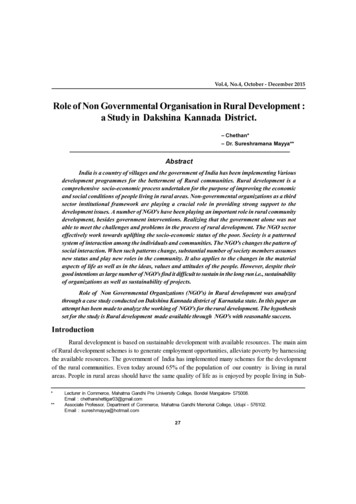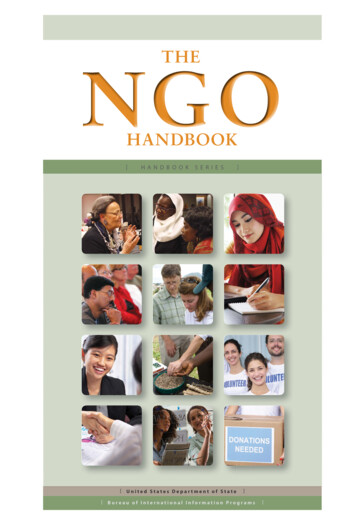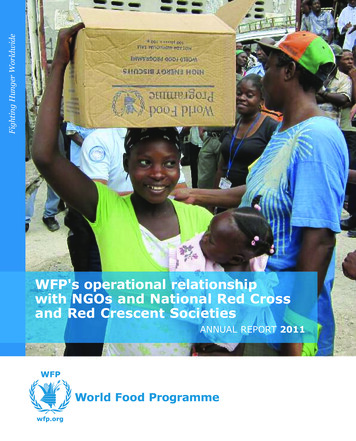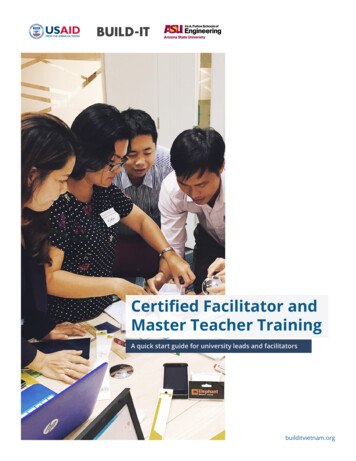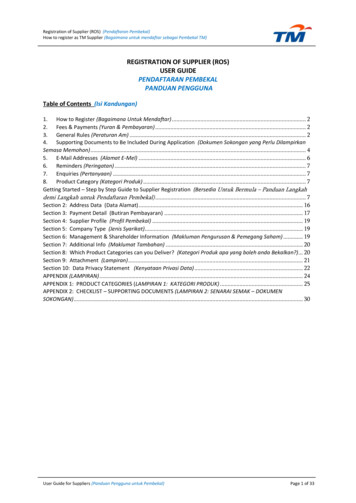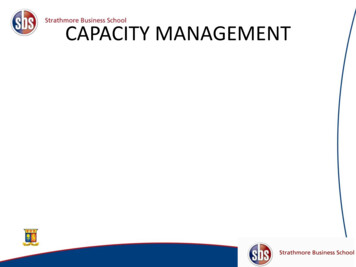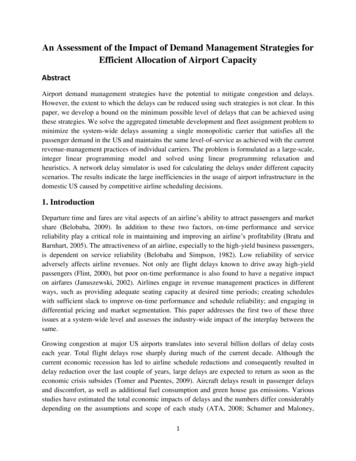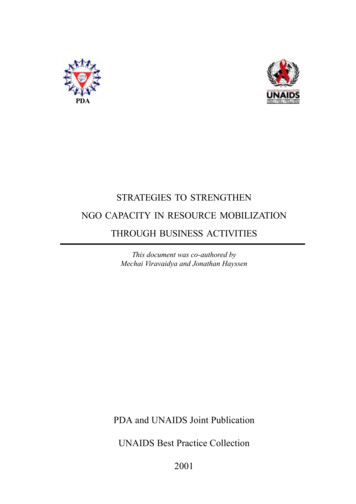
Transcription
PDASTRATEGIES TO STRENGTHENNGO CAPACITY IN RESOURCE MOBILIZATIONTHROUGH BUSINESS ACTIVITIESThis document was co-authored byMechai Viravaidya and Jonathan HayssenPDA and UNAIDS Joint PublicationUNAIDS Best Practice Collection2001
Forewo rdThe work of non-governmental organizations (NGOs) protecting the environment,helping the sick and needy, preserving arts and culture is by nature unprofitable. Traditionally, NGOs rely on the goodwill and generosity of others to cover the costs oftheir activities through grants and donations. Today, unfortunately, NGOs find that suchtraditional funding sources are often insufficient to meet growing needs and rising costs.In addition, restrictions imposed on many grants and donations, along with the uncertaintyof these funds over time, make it difficult for NGOs to do long-term planning, improvetheir services or reach their full potential.When the costs of an NGO s core activities exceed the inflow of grants and donations, it isforced to either reduce the quantity and/or quality of its work, or to find new sources offunds to cover the difference. Reaching out to new donors with innovative fund-raisingapproaches is usually the first step. Redesigning program activities to include costrecovery components, whereby the beneficiaries or clients of the NGO pay part of programcosts, is a second approach. A third alternative is for the NGO to make money throughcommercial ventures.This UNAIDS Best Practice key material is directed at managers of national andinternational NGOs working on HIV/AIDS and other health and development issues. It isintended to increase their awareness of the opportunities, and possible problems,associated with alternative resource mobilization strategies, with a special focus oncommercial activities. It is hoped that this will motivate NGO managers to determine andbegin implementing the most appropriate resource-generating strategies to enable theirorganizations to continue and expand their important work.Policy makers, donor agencies and other supporters of NGOs also have a vested interest inseeing NGOs achieve financial sustainability. It is therefore hoped that this paper willencourage such readers to increase their efforts to promote such institutional developmentfor NGOs. Non-government organizations make our world a better place. Together wecan ensure that they continue to grow and prosper.
TableChapterI.ofC o n t e n t sThe Funding Challenge Facing NGO Managers.1Chapter II.The Response to Date.3Chapter III.Achieving Financial Security through Diversification.5Chapter IV.Strategies for NGO Commercial Ventures: An Overview.12Chapter V.The NGO as Business Owner: Special Considerations.14Chapter VI.Getting an Idea and Planning the Business.16Chapter VII.Conclusion: The Question of Timing.22
1C h a p t e r 1.The Funding ChallengeNGO ManagersDespite the vast differences among theworld s non-governmental organizations(NGOs), most share a common dilemma:Lack of funds limits the quantity and/or quality of the important work theydo. Unlimited needs chasing limitedresources is a fundamental fact ofeconomic life in rich countries andin poor countries. It affects largeinternational organizations, such asthe United Nations, down to thesmallest local NGOs. From ruraldevelopment agencies to museums, andfrom health care providers to educationand training institutes, managers ofNGOs must often pay as much (if notmore) attention to finding funds as theydo to using those funds.NGOs increasingly find that grants anddonations are inadequate to meet currentprogram needs, much less to expandprogram activities. With so manyworthy causes that address genuineneeds competing for the attentionand generosity of the public, evenwealthy donors lack the resourcesneeded to fund every worthwhileeffort. Furthermore, as populationsgrow, so do the numbers of vulnerablegroups needing assistance fromNGOs. New problems can appear, suchas HIV/AIDS, which demand urgentattention and require substantialFacingfunding. Meanwhile, NGOs facerising costs for staff and other programinputs, further straining their limitedbudgets.Dependence on grants and donationscan also inhibit the autonomy ofNGOs to choose which programactivities to undertake and to selectthe most effective interventionstrategies to achieve program goals.To a certain extent, all donors havetheir own agenda, i.e., their own viewsas to which problems are importantand the best intervention strategiesto address these problems. NGOmanagers may be compelled to follow the money and allow donorsto dictate the scope and direction oftheir activities, or else receive nofunds at all. As the old saying goes, beggars can t be choosers. Another problem is that many grantsand donations carry restrictions onthe types of expenses that they maycover. The most common restrictionis to cover only direct programcosts, but not the cost of supportservices or other overhead costsincurred by the NGO. The NGOsmust contribute these costs ontheir own, or at least cover anincreasing share of these costs overtime. But how?
Strategies to Strengthen NGOCapacity in Resource Mobilizationthrough Business Activities2Even those NGOs fortunate enoughto be fully funded in their currentoperations may face uncertainty overfuture funding. If the problems theyaddress are still around in five, ten,twenty years, will donors keep payingprogram costs ad infinitum? Or willdonors generosity shift to other moreneedy or more popular causes? As onecountry develops economically, willdonations be diverted to other, poorercountries? Could local political orsocial problems lead to a cut-off ofdonor support? What if a key donoritself goes out of business? Theuncertain continuity of donor funding,be it short term or long term, makesit extremely difficult for NGOmanagers to plan and implement theirorganization s core activities. It alsomay force an NGO to live a projectto-project existence, being unable tomake long term plans to expand coreactivities or to improve the qualityof program services.Thus we see that today s NGOmanagers face an increasing need fortheir organizations services, increasingcosts for providing those services, andan increasingly competitive andrestrictive environment for obtainingfunds through grants and donations.At best, these problems preventNGOs and those they serve fromreaching their full potential; at worst,the very survival of many NGOs isat stake. The challenge facing NGOmanagers is to find ways to increasetheir financial security withoutsacrificing the mission of theirorganizations.There is no standard, proven methodto meet this challenge. All NGOs aredifferent in terms of their missions,philosophies, client bases, skills andexperience. But increasing financialsecurity is an important part ofplanning for all NGOs. Becomingcompletely independent of donorsmay be a realistic goal for someNGOs, while trying to self-generatefunds just to cover overhead costsmay be more suitable to others. Stillothers may legitimately determinethat relying on grants and donations,at least for now, is the best approach.There is no right answer. It is up toeach NGO and its managers toconsider all the funding optionsavailable and to choose the mostappropriate mix, just as they mustdetermine which core activitiesand implementation strategies aremost appropriate to their missionand goals.
Strategies to Strengthen NGOCapacity in Resource Mobilizationthrough Business Activities3C h a p t e r II.The Response to DateThe funding challenge described earlieris already well understood by mostNGOs, and many have responded withthe same entrepreneurial spirit, goodplanning and hard work that broughtthem success in their core activities.They have expanded fund-raisingactivities directed at the generalpublic, tapped new corporate donorsfor monetary and in-kind support,and held one-time events such asthe LIVE/AIDS concert. They haveredesigned program implementationstrategies to include cost-recoverycomponents whereby the beneficiariesof the program pay part, and sometimesall, program costs. And today we evensee NGOs owning and managingrestaurants, tour companies, banks,clinics and other businesses.Consider the case of museums. Ageneration ago, most covered theircosts through wealthy patrons, civicgrants, and minimal admission fees.Now, museums commonly haverestaurants to feed their visitors,operate shops that sell reproductionsof their unique artworks along withother products that appeal to the tastesof museum goers, and rent out theirexhibition halls for private receptionsand events.Likewise, Goodwill and Oxfamhave long operated retail storesto subsidize their developmentactivities, and T-shirts and otherpromotional items sold throughshops, catalogs and the internet arenet sources of cash for CARE, Savethe Children, the World Wide Fundfor Nature and many other NGOs.Cards and calendars from UNICEFare popular worldwide, while theUN also operates shops at its majoroffices, implements programs inpartnership with private companies tooffset costs, and seeks donationsoutside its traditional source ofpayments by governments.Large, broadly based NGOs aregenerally better equipped to diversifytheir funding sources than smallerNGOs. They can take advantageof their recognizable name andlogo. They have more technicalskills on which to build commercialactivities. They have more contactsand connections with outside groupswith which to form partnerships.And internally they have moreexperience adopting new programsand adapting to organizational change.These NGOs also often have a greaterneed to seek outside fundingbecause of their higher costs for
Strategies to Strengthen NGOCapacity in Resource Mobilizationthrough Business Activities4support services and overhead. On theother hand, smaller NGOs havethe advantage that relatively smallamounts of self-generated funds canmake a big difference in ensuringtheir financial viability. For example,Green Line, a small environmentalNGO in Slovakia, covers approximatelythree-fourths of its operating budgetthrough membership fees, trainingcharges, and the sale of books, gamesand promotional items.Among outside supporters of NGOsthere is the beginnings of a movementto help NGOs become morefinancially secure, but much moreneeds to be done. National andlocal governments increasingly areproviding program grants for NGOsto undertake activities that thegovernments support but can tprovide as effectively by themselves.Some also give general supportgrants to cover NGO overhead costs,reasoning that these funds will beleveraged many times over by thegrants the NGOs receive from outsidedonor agencies. And more and moregovernments have begun changing taxlaws and other regulations thatrestrict the ability of non-profitorganizations to charge fees or engagein profit-making ventures.The large international donor agencieshave long encouraged NGOs tobecome self-reliant, while onlyrecently starting to fund projects thatinclude commercial components. Butmany donors still have restrictiverules and political or philosophicalconcerns about financing businessventures, and none have majorprograms directed specificallyat empowering NGOs throughprofit-making enterprises. Smallerdonor agencies such as German AgroAction, Enterprise Works Worldwide,the Roberts Enterprise DevelopmentFund, NESsT, the Aspen Institute andother private foundations have beenmore active in helping individualNGOs establish businesses, and intrying to upgrade the commercialskills of the NGO community asa whole. Unfortunately, these effortsare still small and largelyuncoordinated.
Strategies to Strengthen NGOCapacity in Resource Mobilizationthrough Business ActivitiesC h a p t e r III.Achieving Financial Security through DiversificationAny smart private investor will saythat the key to financial security isdiversification, i.e., holding a mixedportfolio of investments rather thandepending on a single investment tomeet current and future income needs.If you put all your eggs in one basket you and your family run the risk ofhardship, or even ruin, if the basketdrops. This cardinal rule of investingalso holds true for NGOs that needa secure flow of income to meetcurrent and future program needs.In choosing the optimal mix ofinvestment holdings to providefinancial security, private investorsmatch their portfolio to their individualsituation, i.e., their current livingexpenses, planned future expensesfor children s education, a bigger home,retirement needs, etc., with theirpersonal philosophy or attitude towardrisk. In selecting specific investments,they focus on areas where they havespecial knowledge, experience orinterest, and weigh the expected returnon the investment with the time andeffort required to oversee it. And inoverseeing their portfolio, they keepabreast of developments affectingtheir investments and change the mixas circumstances dictate. This processparallels how successful NGOsmanage their portfolio of fundingsources to meet their particularfinancial security needs.NGOs can obtain funds to run theirprograms from three sources:1) Interested third parties, whogive to the NGO in return,primarily, for the personalsatisfaction derived fromdoing good (grants anddonations);2) Beneficiaries of the NGOsprograms, who value theirparticipation more thanthe cost of participating(cost recovery);3) Unrelated third parties, whowill pay the NGO in returnfor something of value thatthe NGO can make or do forthem (commercial ventures).Problems and opportunities relatedto each of these funding sources arediscussed in turn below. How theyfit with each NGO s particularneeds, abilities and philosophy,however, can only be determined bythe management of the NGO itself.GrantsandDonationsGrants and donations have traditionallybeen the mainstay of NGO funding,
Strategies to Strengthen NGOCapacity in Resource Mobilizationthrough Business Activities6and much has been written on how toorganize fund-raising campaigns.Clearly, the more an NGO can tap thegoodwill of the public for support,the more it can devote its timeand energy directly on its mission.After considering their fundingoptions, many NGOs might determinethat relying fully on philanthropicsupport is the best fit with theirorganization s needs, abilities andvalues. But even in these cases, NGOsare wise to diversify their base ofphilanthropic support rather thanbeing dependent on a single source.The market of potential donors toNGOs doing good work in an area ofgenuine public concern is very large.It is also a very diverse market thatcan be broken down into marketsegments. Possible ways an NGOfighting HIV/AIDS might segment itspotential donor market are given below.The list is far from exhaustive ordetailed. Rather, it is intended toillustrate the market-driven approachthat successful NGOs use to tapdonor support. The market for cash donationsfrom individuals might requiredifferent approaches for:1) Wealthy individuals who candonate large sums,2) Middle income earners whocan give regular, moderateamounts, such as throughmembership fees,3) The general public who mightgive to collection boxes placedat local businesses, and4) People with internet access. The market for volunteers mightinclude:1) Medical students to care forAIDS patients in return forexperience or school credit.2) Retirees with professionalskills to be pro bono consultants.3) Other concerned individualsto help with administrationand fund-raising. Corporate donors can besegmented into potential sourcesof in-kind donations of neededequipment and supplies, or sourcesof cash. Companies whosebusinesses somehow relate tothe NGO s work could beapproached differently fromcompanies with totally unrelatedbusinesses. Businesses locatedin the NGO s neighborhood areanother possible segment. Community clubs and associationscan give donations or organizeone-time charity events with theproceeds going to the NGO.Another segment could be thesocial clubs of the expatriatecommunities.Goodwill is not the only reasonpeople give to worthy causes. Toappeal for donations, NGOs mustunderstand the motivation of theirpotential donors, just as commercialmarketing executives must understandthe different tastes and preferences of their varied customers. Some donorsmay wish to support only one aspectof the NGO s work. Corporationsare often especially interested inthe public relations benefits ofsupporting NGOs, while individualsmay also want some form ofrecognition of their support. Somedonors may want the chance tointeract with the end recipients oftheir donation or to otherwise
Strategies to Strengthen NGOCapacity in Resource Mobilizationthrough Business Activitiesparticipate in the NGO s efforts.Others may require direct feedbackon how their donations were used.And even donors with purely altruisticmotives may increase support if theyare kept abreast of the organization sactivities. Sometimes a donor s motivesmay actually be detrimental to theorganization, e.g., to obtain politicalsupport or to impose his or her will onthe direction of the NGO s work. NGOsthat recognize and respond to themotivations of potential donors will bemore succesful at competing fortheir support.The concept of segmenting marketsand designing different approaches foreach segment is really not all thatnew to most NGOs. An NGO fightingHIV/AIDS, for example, segmentsthe market of potential programparticipants into intravenous drug users,the homosexual community, commercialsex workers, students, etc., and designsdifferent intervention strategies foreach. NGOs that have been successfulat applying for grants have learned tosegment the market of potential donoragencies by the types of projects theysupport (training, women s issues, theenvironment, etc.), the interventionstrategies they prefer and the amount offunds they can provide. These NGOstailor their grant proposals to match the tastes and preferences of differentdonors.CostRecoveryWhen an NGO s programs bring realvalue to its beneficiaries, manybeneficiaries (but perhaps not thepoorest of the poor) will gladly paysomething to participate in theprograms. By selling rather thangiving away their services, NGOs canrecover part or all of their costs, betterallocate their services to those whotruly value them, and enhance theself-esteem and commitment ofparticipants. More and more NGOsare thus designing interventionstrategies that incorporate costrecovery components through fees-for-services or various loan andcredit arrangements.For example, Les Centres pourle Developpement et la Sante (CDS)in Haiti received a grant to installa drinking water system in a slumarea of the capital Port-au-Prince.Residents pay a per bucket fee forthe water, which covers all operatingand maintenance costs of the systemand also generates a surplus thatis used to improve solid wastecollection in the neighborhood. Inanother example, social marketingprogramsforcontraceptivestypically charge for condoms andoral contraceptives, albeit atbelow-market prices. Requiringparticipants to contribute labor isanother form of fee-for-service. Forexample, food aid recipients may beasked to donate labor to sort, packageand deliver food supplies.In Sri Lanka, the rural developmentphilosophy of the SarvodayaShramadana Movement is centeredon the principle of the gift of labor and hundreds of thousands ofindividuals have taken part. The valueof that labor is immeasurable.Loan and credit arrangementsrequire recipients to pay back costsover time. The loans may be interestfree, or with interest rates belowwhat participants could get from
Strategies to Strengthen NGOCapacity in Resource Mobilizationthrough Business Activities8private banks and money lenders. TheGrameen Bank of Bangladeshpioneered in this area through itsmicro-credit programs, and othergroups such as KREP in Kenya andBancoSol in Bolivia have also beenable to establish profitable bankingoperations that directly serve the poor.All such cost recovery activities adda commercial component to the workof NGOs. The staff must startthinking in business terms, and have tolearn specific business skills andconcepts such as pricing, distributionchannels, and cost accounting. Theymust also learn the ins and outs ofthe businesses of their borrowers ifthey are to administer loan programseffectively. The skills and experiencegained may be the first step in enablingthese NGOs to start their owncommercial ventures.Cost recovery activities also bringNGOs face to face with the harshrealities of the marketplace, whichcan fundamentally conflict with anNGO s compassionate mission andvalues. In the commercial world,businesses that don t make enoughmoney have to cease operating. For thatreason, people who cannot pay must dowithout, risky loan applicants areturned down, and defaulters lose theircollateral. Sadly, NGO programs thatdepend on cost recovery componentsto sustain themselves may have toexclude from participation some ofthe people that the NGO most wishesto help.Consider the social marketing ofcontraceptives. These programs needto bring in sales revenue to helpcover their costs, while most of theirpotential customers recognize thevalue of the products and will happilypay something for them. But the lawof supply and demand says that asthe price of contraceptives goes up,demand for contraceptives goes down.Charging higher prices can improvethe bottom line of these programs,but at the expense of hurting theirultimate goal to increase familyplanning practice rates. Furthermore,no matter how little the NGO chargefor their products, some people maystill be unable to pay.Cost recovery programs demand thatNGO managers make a trade-offbetween their programs social goalsand financing needs. They musttry to serve the greatest numbersof beneficiaries while generatingsufficient funds to meet whateverpercentage of program costs are notcovered by donations or subsidiesfrom other activities of the NGO.There is no optimal balance, andsome may have to be left out. Butbeing able to help some people ona sustainable basis is better thanhelping no one at all. Hopefully, eachNGO can find alternative ways tosubsidize or otherwise assist thoseunable to participate.This dilemma demonstrates why it isso much more difficult to manage anNGO compared to a strictly for-profitbusiness. The predominant goal ofbusiness managers, even in the mostsocially responsible companies, is tomaximize the return to shareholders.If a price increase is expected toreduce sales but increases profits,the price increase is approved. Ifa product line or service loses money,it usually is dropped. NGO managers,
Strategies to Strengthen NGOCapacity in Resource Mobilizationthrough Business Activitieson the other hand, must try to maximizethe use of their services, while being asconcerned about the bottom line astheir for-profit counterparts. NGOsvalue the continuation of their money-losing core activities andmust earn resources from otheractivities specifically to help pay for,or cross-subsidize those activitiesthat are not financially viable.CommercialVenturesMillions of farmers, street vendors,artisans and tradesmen managesuccessful businesses around theworld. And the success and rapidexpansions of micro-credit programshave shown that even the least educatedand poorest of the poor can run profitablebusiness enterprises. Despite this, manypeople still believe that NGOs areinherently unequipped to compete incommercial markets.Actually, successful NGOs already havemost of the skills required for business,and their managers think in businessterms more than we realize. The bestNGOs are clearly as entrepreneurial asthe best private companies, being ableto make things happen and createsomething out of nothing. Likecommercial marketers, these NGOsfind under-served segments of thepopulation and design products andservices to meet the needs of thosemarkets. Good NGOs are effective inhiring and training staff, planningand budgeting, strategic planning,purchasing, public relations and otherareas of management. Finally, theseNGOs have a proven ability to acquirespecialized knowledge and technicalexpertise related to their fieldsof operations and the businesses oftheir beneficiaries. The level ofsophistication may vary, but the basicskills are there.Two NGOs from the developingworld that have been particularlysuccessful at diversifying theirsources of funding and expandinginto business ventures are theBangladesh Rural AdvancementCommittee (BRAC) and thePopulationandCommunityDevelopment Association (PDA)of Thailand. BRAC was foundedin 1972 to aid refugees returninghome after the country s war forindependence. It has since grown tobecome one of the largest and mostbroadly based NGOs in the world, witha staff exceeding 25,000 and anannual operating budget over US 100million, of which less than fortypercent now comes from grants anddonations. BRAC s core activities aretargeted at the destitute, the illiterateand the landless, encompassing ruraldevelopment, education and training,health and population, and urbanprograms.Managers at BRAC recognized earlyon that self-reliance for its targetgroups and self-reliance for theorganization went hand in hand. Allof its programs from animal raisingto credit programs to the productionof low-cost education materials aredesigned to optimize cost recoverywhile serving those in need. Programsthat generate surpluses above theirongoing costs are used to crosssubsidize other valued programs. Sixtypercent of BRAC s budget comesfrom these surpluses.
Strategies to Strengthen NGOCapacity in Resource Mobilizationthrough Business Activities10BRAC has also been very successfulat expanding into commercialventures that are consistent with theorganization s mission and generatesubstantial profits. BRAC Printersbegan in 1977 to meet BRAC s ownprinting needs, and has since beenspun-off as a separate entity thatprovides high quality printing servicesto private sector clients. The Aarongcraft shops owned by BRAC bringincome to thousands of rural craftproducers and profits to theorganization. BRAC s Cold StorageFacility helps potato farmers to storetheir output until prices rise, benefitingboth the farmers and BRAC, while itsDairy and Food Project generates asurplus by linking rural milk producerswith urban markets. Recently, BRAChas joined with other non-profitand for-profit organizations inestablishing the Delta BRAC HousingFinance Corporation to promoteaffordable housing, and its new BRACInformation Technology Institute(BITI) aims to become one of thelargest such institutes in South Asia.Thailand s PDA is most well knowninternationally for its early pioneeringwork in family planning and morerecently for its success in tacklingThailand s AIDS problem. Theorganization began in 1974 byestablishing one of the world s firstrural-based social marketing programsfor contraceptives, supported byinternational grants, a network of over16,000 volunteer distributors and feescharged for its products. Once thisprogram was well established, PDAexpanded its efforts to improve ruralliving standards with projectsin primary health care, waterresources, agricultural marketingand small-scale industries.Mechai Viravaidya, the founder ofPDA, has been one of the earliest andmost vocal proponents of NGO selfreliance. Today, PDA covers overseventy percent of its annual budgetfrom its own resources and it aims tobe 100% self-sufficient by theend of the decade. Most of the incomegenerating activities are managedby PDA s affiliate, the PopulationDevelopment Company Limited(PDC), which is incorporated as abusiness entity but with by-lawsrequiring that all profits be donated toPDA. PDC operates for-profit medicalclinics in Bangkok and majorprovincial cities, owns restaurants( Cabbages and Condoms ), minimarts and a handicraft shop, andmarkets a creative line of promotionalitems (key chains, t-shirts, coffee mugs,etc.) using condom and other familyplanning motifs. Other income earnersfor PDA include contracting out itsresearch and training divisions toprivate clients and the rental of officespace and conference facilities.The growth of PDA s Cabbages andCondoms restaurants illustrates how a mini-venture can grow into a highlyprofitable enterprise. It all beganwhen PDA staff and their friendsused to gather informally after workfor snacks, drinks and conversationin the small garden attached to PDA sheadquarters. As its popularity grew,menu items were added and therestaurant expanded several times.It now operates out of a separatebuilding next to PDA, has become oneof Bangkok s most popular Thairestaurants with gross revenuesapproaching US 75,000 per month,and has expanded with branches inother cities.
Strategies to Strengthen NGOCapacity in Resource Mobilizationthrough Business ActivitiesIn 1988, PDA began one of its mostinnovative and potentially far-reachingprograms ever, the Thai BusinessInitiative in Rural Development, orTBIRD. The TBIRD concept is tomatch rural needs for better businessskills and marketing opportunitieswith the money and especially thetalents of private companies. Whobetter to show the way, argues PDA,than the business community? TBIRDtakes advantage of the increasinginterest of corporations to contributeto their country s development andfoster their public image. Theprivate companies provide the fundsand business-specific knowledgeand experience. PDA acts as theintermediary, supplying the skills,lacking in the private companies,to plan and organize village-levelactivities.Linking private companies to ruraldevelopment can take several forms.Some TBIRD companies provideresources to meet the basic needs ofvillagers in water, sanitation or otherinfrastructure. Other companiesprovide funds and technical e
Capacity in Resource Mobilization through Business Activities C h a p t e r II. The Response to Date The funding challenge described earlier is already well understood by most NGOs, and many have responded with the same entrepreneurial spirit, good planning and hard work that brought them success in their core activities. They have expanded .
